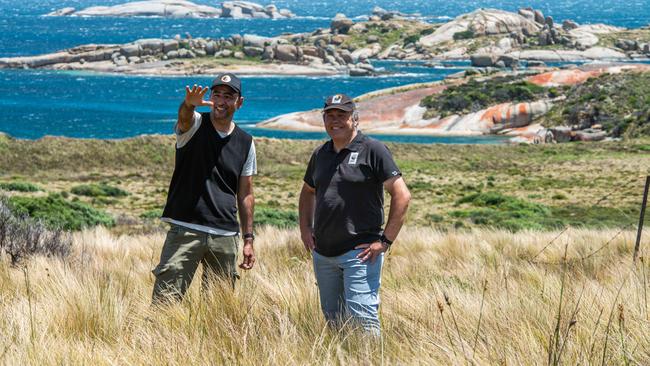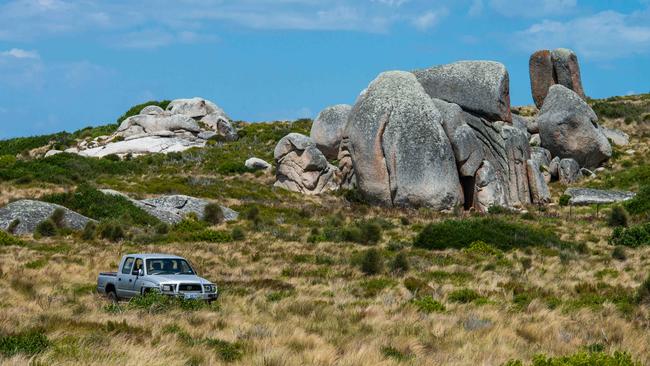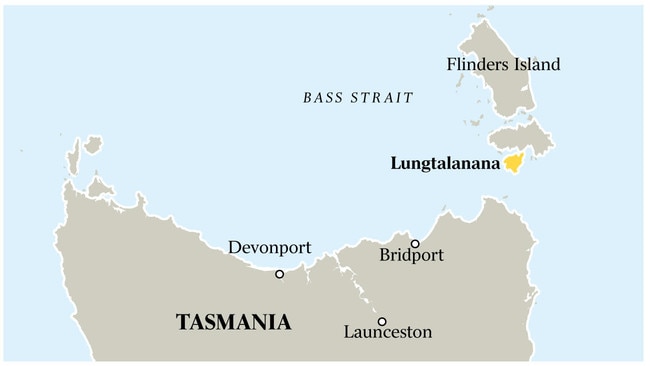Hands-on conservation and Indigenous know-how combine to ‘rewild’ damaged island
On a once-pristine island ravaged by fire and ferals, a team effort is showing how to ‘rewild’ damaged landscapes.

Fire and ferals have ravaged the timeless island of Lungtalanana, but the tide is turning; hands-on conservation and Indigenous know-how combining in a new model for “rewilding” the nation’s damaged landscapes.
Also known as Clarke Island, Lungtalanana is a jewel of Bass Strait’s Furneaux Group, with orange lichen-splashed granite, white sandy beaches and crystal-clear turquoise waters.
However, it has suffered severely from European-Australians’ introduction of a menagerie of now-feral pests, including mice, rats, rabbits, cats and even cows.
All have taken a devastating toll on a once rich array of native flora and fauna, some key species wiped from the 8230ha island northeast of Tasmania.
Compounding the damage, an absence of Indigenous burning contributed to a build-up of vegetation that in 2014 caused an intense bushfire that blighted 80 per cent of the island’s landmass.
But now a landmark partnership between the Indigenous owners – to whom legal title was fully returned in 2005 – and the World Wide Fund for Nature, aims to “rewild” the entire island.
“This is a groundbreaking project, bold with probably a high element of risk, but the type of project we have to do more of,” said Darren Grover, WWF-Australia’s head of healthy land and sea scapes.
The ambitious project, with a $1.5m price tag, will be kickstarted by $330,000 from WWF, and aims to test the benefits of rewilding entire landscapes, rather than just patches of bush or single species reintroduction.

“More than that, what we have here is much bigger than a wildlife conservation project – it’s about restoring culture and heritage,” Mr Grover said.
“What we do here in the coming years will be a learning exercise, as we bring back different species and the land is subject to traditional land management practices. What we learn may be applied to a bigger island or back on the Australian mainland.”
The first species slated for reintroduction are the Flinders Island wombat – a smaller, lighter-haired variant – Bennett’s wallaby and the short-beaked echidna. Subsequent candidates include threatened species such as the southern brown bandicoot, long-nosed potoroo and eastern quoll. Each plays an important ecological and cultural role in the landscape.
A program of targeted, low-intensity Indigenous burns by Pakana Rangers, employed by the Tasmanian Aboriginal Centre, will guard against future catastrophic wildfire.

“Recent studies on Lungtalanana have shown Aboriginal people managed this land with fire for at least 41,000 years,” said TAC land and heritage co-ordinator Andry Sculthorpe. “The loss of cultural burning practices, which reduced fuel loads, has been devastating. A return of cultural burning is crucial to the restoration of the island and is a strong signal of the Indigenous community’s ongoing connection to Lungtalanana.
“Species will benefit from a mosaic of vegetation that has been burnt at different timescales. Country needs people and it needs animals too.”
Mr Sculthorpe said the project, a collaboration with the University of Tasmania, would provide opportunities for young Aborigines, and ensure an island important to his people for millennia also played a key role in their future.
For the broader Australian community, too, it offers a beacon. “We are almost turning the clock back, in the sense of wildlife and environment, but also in terms of people and culture, as well,” Mr Grover said. “This project will only succeed by bringing those two together.”



